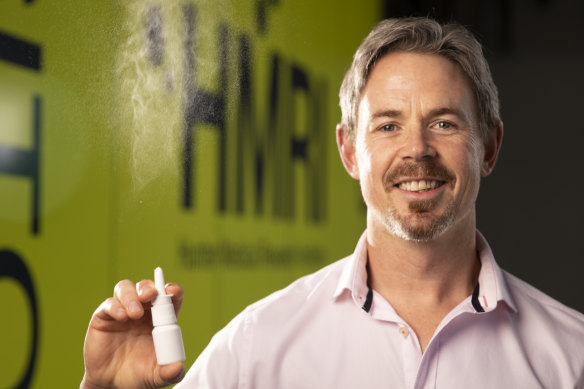Key points
- Nasal vaccines stop COVID-19 at the point of entry: the nose.
- Current vaccines are great at stopping us getting seriously ill and dying.
- Nose vaccines offer important advantages in preventing infection altogether.
- Several vaccines are in late-stage trials.
Vaccines sprayed inside the nose could hold the key to stopping the COVID-19 waves the world continues to battle, scientists say – if some key challenges can be overcome.
Several nasal vaccines are in late-stage development, including two in Australia.
Associate Professor Nathan Bartlett with a prototype of the COVID-19 nasal vaccine he is working on.Credit:Peter Stoop
SARS-CoV-2, the virus that causes COVID-19, primarily enters the body through the nose. A vaccine that blocks it at the frontline could offer not just protection against severe illness – as current vaccines do – but against infection altogether.
“If you can prevent transmission then we are much further down the line to achieving herd immunity,” said the University of Melbourne’s Professor Jean-Pierre Scheerlinck, who has published a review of mucosal vaccination.
For those reasons, a nasal vaccine has been a long-held dream for many. But problems, including how to dose someone with a blocked nose or what to do if they sneeze, have held back the science.
“We can do it, it is achievable” said Mariusz Skwarczynski, Australian editor of the journal Vaccines. A nasal vaccine would mean “we can stop the infection even before it reaches inside our body. This is a huge advantage compared to injectable vaccines, they cannot do it”.
“But,” Skwarczynski said, “there is a lot of but.”
The mucosal immune system lines our airways and is the first line of defence against airborne viruses such as SARS-CoV-2.
The largest army of immune cells in the body work together to filter out all the pathogens we inhale every day, defeating viruses and other invaders without us ever knowing.
But viruses have evolved tricks of their own, allowing them to infect the cells and use its molecular machinery to copy itself over and over before spreading down into the lungs and the rest of the body.
Current generation COVID-19 vaccines offer fantastic protection against serious illness and death by recruiting antibodies in the blood that can block the virus spreading to the organs. But these vaccines struggle to generate antibodies in the nose.
“The big issue is infection. The current gen of vaccines don’t stop infection,” said Associate Professor Nathan Bartlett, head of viral immunology at Hunter Medical Research Institute and the University of Newcastle. The virus can continue to circulate, attacking the vulnerable and finding new ways to mutate around our defences.
At least eight nasal vaccines for COVID-19 are in development, according to the World Health Organisation.
They include a phase 1 trial of Tetherex’s nasal COVID-19 vaccine SC-Ad6-1 led by the University of Queensland’s Associate Professor Paul Griffin. The spray contains a harmless virus modified to look like SARS-CoV-2. The virus infects nose cells and replicates – theoretically prompting the immune system into a strong response.
People wear face masks in Melbourne in July.Credit:Getty
Bartlett is working with ENA Respiratory to develop INNA-051, a nose spray full of molecules that bind to cell receptors that trigger the body’s powerful innate immune system, which is capable of fighting off viruses without needing antibodies or T cells. “It gives the immune system a head start,” Bartlett said.
However, that head start lasts only a week. Bartlett expects the spray would need to be used every week to maintain protection.
In animal trials, the treatment dramatically reduced COVID-19’s ability to replicate in the nose. The treatment – Bartlett is careful not to call it a vaccine – is now in phase 2 clinical trials in humans.
Nasal vaccines face a key challenge: getting a strong and long-lasting immune response in the nose.
The nose is constantly exposed to viruses, bacteria and pollution, so every time we breathe in, immune cells there are much less aggressive than in other parts of the body.
“All the stuff we’re breathing in, if we responded aggressively, we’d have a lot more allergies,” Griffin said. And antibodies generated in the nose are typically short-lived.
Another problem is getting the dose right. This is easy with a syringe into a vein, but very difficult when spraying fluid into the nose. What if the user’s nose is blocked? What if they sneeze? The vaccines also need to be carefully designed to not cause an allergic reaction.
And then there is the mucus itself. Vaccines need to penetrate it to get an immune response and then must stay around long enough to really fire up the system – a tough task when mucus is constantly being cleaned out of the nose.
Griffin said he was “confident we’ll get at least one intranasal protection” soon. Bartlett is less so. He points out that regulators are unlikely to offer quick emergency approval to new vaccines now and any vaccine that gets approved would likely be out of date immediately, as the virus continues to mutate.
“Whether it will have a huge impact on this pandemic, I’m not sure,” he said. “But it’s critical for protecting us against the next one.”
Stay across the most crucial developments related to the pandemic with the Coronavirus Update. Sign up for the weekly newsletter.
Most Viewed in National
From our partners
Source: Read Full Article

